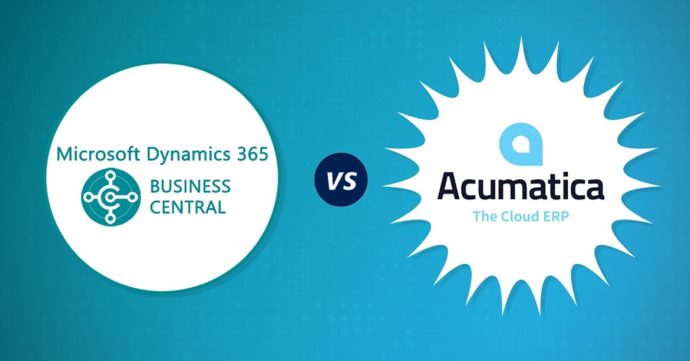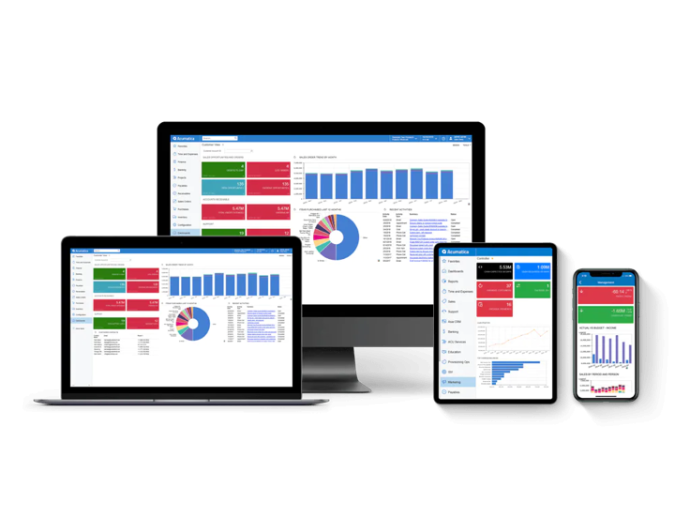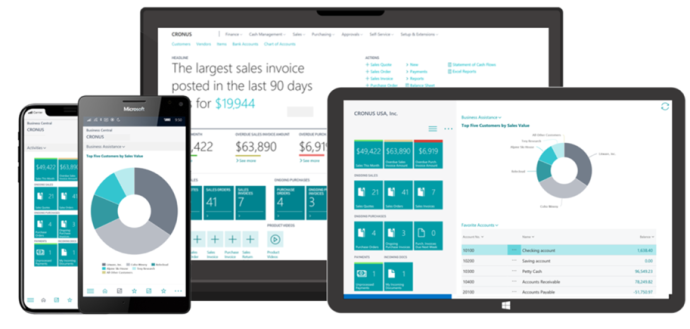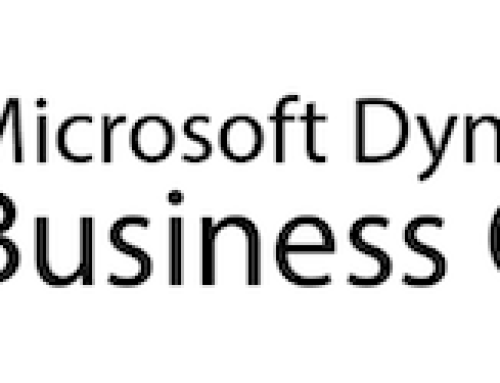
As a business owner or manager, you know that mastering accounting is essential for the success of your company. To stay ahead in today’s competitive business environment, you need an Enterprise Resource Planning (ERP) solution that streamlines your operations, improves efficiency, and boosts productivity. There are numerous ERP solutions available in the market, making it challenging to select the best one for your business. Acumatica and Dynamics BC have emerged as two leading options for SMBs, each offering unique features and benefits. Let’s take a closer look to find which is the best ERP solution for your business by comparing the features, benefits, and factors to consider when choosing between Acumatica vs Dynamics BC.
STOP – Don’t want to read the rest of this blog? Call us at (860) 485-0910 and have
a no-strings attached conversation to see what fits your business needs best.
What is Acumatica?
Acumatica is a cloud-based ERP solution designed for small and medium-sized businesses. It offers a suite of fully integrated applications, including financial management, customer management, distribution management, project accounting, and manufacturing management. Acumatica’s financial management module provides a comprehensive set of accounting features, such as general ledger, accounts payable, accounts receivable, cash management, and tax management.
The platform also offers a user-friendly dashboard, customizable reports, and real-time data analytics, making it easy for businesses to monitor their financial performance. Acumatica’s mobile application enables users to access the system from any device, anytime, anywhere.
Benefits of Acumatica for SMBs

Acumatica offers several benefits for small and medium-sized businesses. First and foremost, its cloud-based architecture allows for easy scalability and flexibility, catering to the changing needs of growing businesses. Acumatica’s pay-as-you-go pricing model is also attractive to SMBs, as they only pay for the resources they use. needs of growing businesses.
Additionally, Acumatica’s robust customization capabilities enable businesses to tailor the system to meet their unique requirements. The platform’s seamless integration with third-party applications and tools, such as CRM systems and e-commerce platforms, further enhances its appeal for SMBs.
What is Dynamics Business Central?
Dynamics Business Central is a comprehensive ERP solution from Microsoft, specifically designed for small and medium-sized businesses. The platform offers a wide range of functionalities, including financial management, supply chain management, project management, operations management, and customer relationship management.
Dynamics Business Central’s financial management module covers all essential accounting aspects, such as general ledger, accounts payable, accounts receivable, budgeting, and fixed assets management. The platform’s intuitive user interface, built-in business intelligence tools, and integration with other Microsoft products, such as Office 365 and Power BI, make it a compelling choice for SMBs.
Benefits of Dynamics Business Central for SMBs
 Dynamics Business Central offers numerous advantages for small and medium-sized businesses. Its tight integration with Microsoft’s ecosystem allows for seamless collaboration and streamlined processes, resulting in improved efficiency and productivity. The platform’s user-friendly interface and familiar Microsoft look and feel make it easy for employees to adopt and use, reducing the learning curve.
Dynamics Business Central offers numerous advantages for small and medium-sized businesses. Its tight integration with Microsoft’s ecosystem allows for seamless collaboration and streamlined processes, resulting in improved efficiency and productivity. The platform’s user-friendly interface and familiar Microsoft look and feel make it easy for employees to adopt and use, reducing the learning curve.
Moreover, Dynamics Business Central provides robust customization options and a wide range of industry-specific functionalities, making it suitable for businesses across various sectors. The platform’s scalability and flexibility ensure that it can grow with your business, accommodating your evolving needs.
Comparing Acumatica vs Dynamics BC
Pricing
When it comes to pricing, both Acumatica and Dynamics Business Central offer flexible, subscription-based models. Acumatica operates on a pay-as-you-go basis, where you only pay for the resources you use. This approach can be cost-effective for businesses with fluctuating workloads or seasonal demands. for the resources you use.
Dynamics Business Central offers tiered pricing plans based on the number of users and the level of functionality required. While this pricing structure may be more predictable, it may not be as cost-effective for businesses with varying needs.
Scalability
Both Acumatica and Dynamics Business Central provide excellent scalability options for growing businesses. Acumatica’s cloud-based architecture allows for easy expansion, while its pay-as-you-go pricing model ensures that you only pay for the resources you need. Dynamics Business Central also offers seamless scalability, with the ability to add users and functionalities as your business grows.
Customization
Customization is a critical factor when choosing an ERP solution, as businesses often have unique requirements that need to be addressed. Both Acumatica and Dynamics Business Central offer robust customization capabilities, allowing you to tailor the system to meet your specific needs. Acumatica’s flexible platform and open API make it easy to modify and extend the system, while Dynamics Business Central provides a wide range of industry-specific functionalities and add-ons.
Integration capabilities
 Integration with existing systems and software is another crucial consideration when selecting an ERP solution. Both Acumatica and Dynamics Business Central offer strong integration capabilities, allowing you to connect the platform with various third-party applications and tools. Acumatica’s open API enables seamless integration with popular CRM systems, e-commerce platforms, and other business tools. Dynamics Business Central’s integration with the Microsoft ecosystem ensures a smooth connection with other Microsoft products, such as Office 365 and Power BI.
Integration with existing systems and software is another crucial consideration when selecting an ERP solution. Both Acumatica and Dynamics Business Central offer strong integration capabilities, allowing you to connect the platform with various third-party applications and tools. Acumatica’s open API enables seamless integration with popular CRM systems, e-commerce platforms, and other business tools. Dynamics Business Central’s integration with the Microsoft ecosystem ensures a smooth connection with other Microsoft products, such as Office 365 and Power BI.
User experience
User experience is a vital aspect to consider when choosing an ERP solution, as it directly impacts employee adoption and overall productivity. Both Acumatica and Dynamics Business Central offer intuitive user interfaces and easy-to-use dashboards, making it simple for users to navigate the system and access the information they need. Dynamics Business Central’s familiar Microsoft look and feel may provide an advantage for businesses already using Microsoft products, as employees will likely find it easier to adopt and use.
Factors to Consider When Choosing an ERP Solution
Business size and industry
When selecting an ERP solution, it’s essential to consider the size of your business and the industry you operate in. Both Acumatica and Dynamics 365 Business Central cater to small and medium-sized businesses, offering a range of functionalities that can be tailored to your specific needs. Acumatica has industry specific modules and additional add-ons, Dynamics Business Central has industry-specific features and add-ons, making both suitable for businesses in particular sectors. Taking a closer look at your business needs and what each has to offer to fit those, is step one.
Contact us and walk through a quick 5-question discovery chat and we’ll compare solutions and recommend the best fit.
Budget
Your budget is another critical factor to consider when choosing an ERP solution. Both Acumatica and Dynamics Business Central offer flexible pricing models, but it’s essential to analyze the total cost of ownership and determine which option is more cost-effective for your business in the long run.
Existing systems and software
It’s crucial to consider your existing systems and software when selecting an ERP solution, as you’ll want to ensure that the platform can integrate seamlessly with your current tools. Both Acumatica and Dynamics Business Central offer strong integration capabilities, but Dynamics Business Central’s tight integration with the Microsoft ecosystem may provide an advantage for businesses already using Microsoft products.
Future growth and expansion plans
Finally, consider your future growth and expansion plans when selecting an ERP solution. Both Acumatica and Dynamics Business Central offer excellent scalability options, ensuring that they can grow with your business and accommodate your evolving needs. However, it’s essential to assess the platform’s ability to support your long-term goals and determine which option is better suited to your future requirements.
Making the Right Choice for Your Business
In conclusion, Acumatica vs Dynamics BC Business Central, both are excellent ERP solutions for small and medium-sized businesses, each offering unique features and benefits. When choosing between the two, it’s essential to consider factors such as business size and industry, budget, existing systems and software, and future growth plans. By carefully analyzing these aspects and weighing the pros and cons of each platform, you can make an informed decision and select the best ERP solution for your business.
No matter where you are in your search, we’ve got tools that can help you navigate the process. Here are some links to get your started when deciding between Acumatica vs Dynamics BC:
- Learn more about Acumatica, the Cloud ERP
- Download the Acumatica Product Overview
- Read up on Microsoft Dynamics 365 Business Central
- Download the Dynamics 365 BC Capability Guide
Are you ready to evaluate a new ERP system? Contact CAL Business Solutions. 860-485-0910 x4 or sales@calszone.com.
By CAL Business Solutions Inc., Acumatica and Microsoft Dynamics GP/365 BC Partner, www.calszone.com












